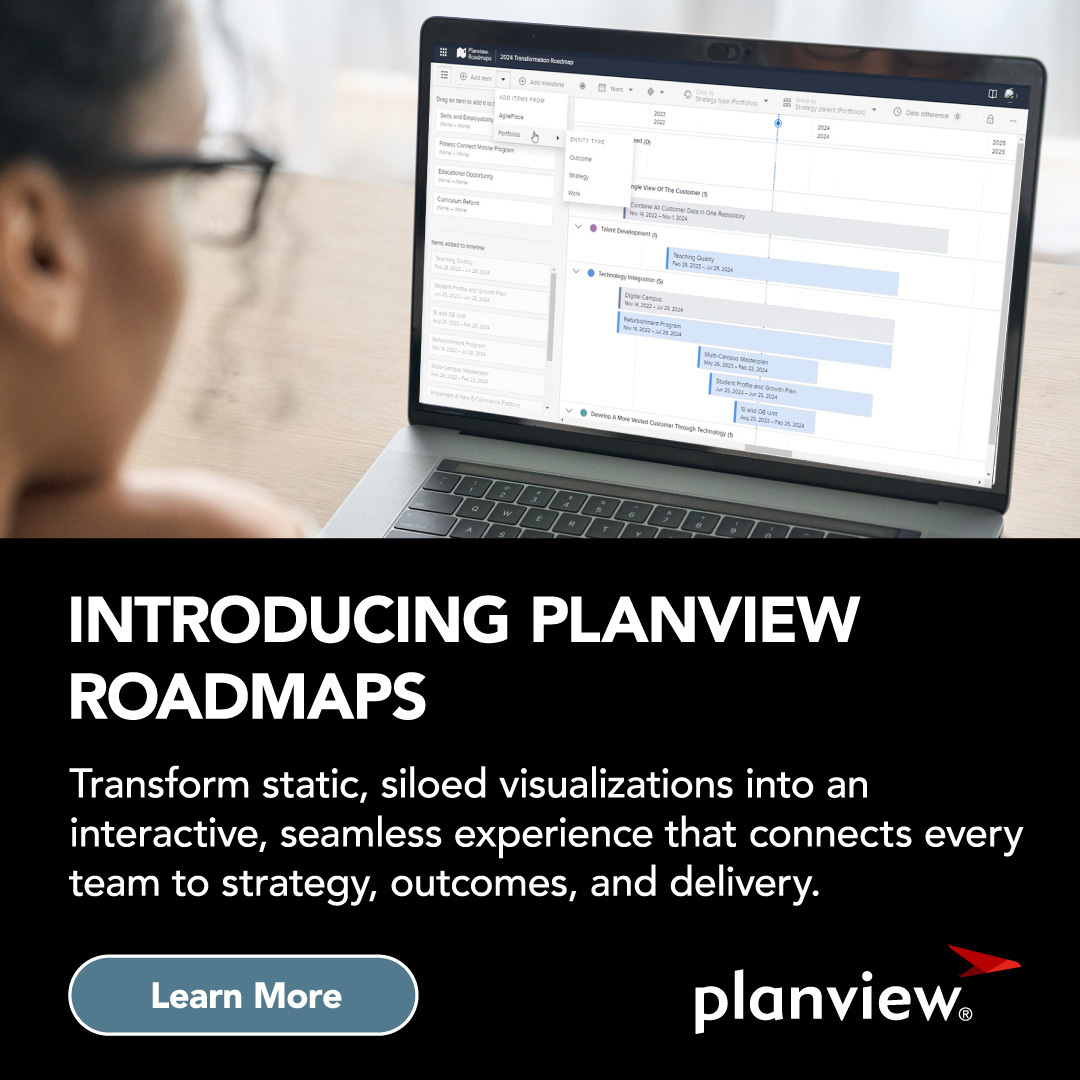
We’re excited to share the backstory behind Planview Roadmaps, one of the newest enhancements we’ve built into the Planview Platform.
This new era of roadmapping transfers the usefulness of having a visual representation of a plan from product managers to anyone in your organization.
In this post, you’ll learn:
- Why we’ve added roadmapping capabilities to the Planview Platform
- Why roadmapping capabilities are particularly valuable for Agile organizations
- How roadmapping can be useful to PMO leaders
- The value of roadmapping for executives
Planview Roadmaps in 30 Seconds
A typical roadmap is a high-level, visual representation of outputs and milestones from a small number of teams.
It’s created and manually updated and reshared in a tool like PowerPoint – and is out of date the minute it’s created.
Planview Roadmaps transforms static, siloed visualizations into an interactive, seamless experience that connects every team and the application where their work is tracked to strategy, outcomes, and delivery.
We sat down with Planview Chief Product Officer Louise Allen for the rest of the story.
Go Deeper: Learn more about why Planview Roadmaps is the end of siloed, static roadmap tools.
Q&A with Planview CPO Louise Allen
What was behind the decision to develop roadmapping now?
We want to improve business agility by connecting the efforts across teams, across all levels of the organization – as I like to say, from the boardroom to the team room.
We want to connect the line of sight across dependencies and deliverables, all to give a unified view of the strategy, outcomes, and associated delivery so that you can react more confidently and faster.
We are reimagining how to utilize the roadmap visual representation to drive alignment not only at the operational, but also at the coordination and strategy levels.
React to what?
To project delays, market conditions, new product opportunities, and new business circumstances. It’s the ability to react to changes and pivot or persevere, and dominate the decision instead of making tactical updates to plans six months after something happens.
A startingly small percentage of enterprises are able to react to major shifts – like COVID-19, or the introduction of AI and machine learning – within the quarter. They’re not agile enough.
In fact, 85% of executives say their organization’s ability to adapt to change falls short.
That’s not to say they’re not running Scrums, or they don’t have product owners – they’re “doing” Agile, but they can’t make quick “pivot vs. persevere” decisions with any confidence because they don’t have a unified view of what’s going on.
What do you mean when you say a unified view?
A “unified view” for roadmaps means two things.
First, we mean a single, shared place where organizations can connect data from Agile, project, product, and waterfall teams. Typically, project teams are completely separate from product or software teams.
Planview Roadmaps brings together all types of teams in one place.
Second, we mean a single, shared place where organizations can connect and roadmap flight levels – strategy and outcomes, as well as delivery.
Those are the differences between a traditional roadmap that a product manager might use, versus what a roadmap should be.
Traditional roadmaps or project plans are output-oriented and focused on deliverables and milestones. A product manager might use a roadmap to track the delivery of a bundle of feature releases.
Strategy needs to be roadmapped, too, so the delivery of features is visualized in context with the larger strategy. And if that strategy shifts, the execution and delivery can shift along with it.
With Planview Roadmaps, teams can connect strategy with outcomes and team milestones, mapping work to critical outcomes and ensuring progress on the most critical initiatives.
Additionally, because plans, strategy, and outcomes are all visible in one view, organizations can confidently articulate the impact of initiatives and how programs are progressing to drive business change.
Did you face any challenges when developing roadmapping, and how did you overcome them?
As a lot of product teams know, it wouldn’t be building a new capability if there weren’t challenges. It’s just another reason why I love being able to visualize the dependencies and deliverables from strategy to delivery, in real time.
Even the marketing teams have jumped in using roadmaps to map out their launch plans.
First, we created a product plan for a product launch and used that to create a roadmap, which included creating a free trial, creating SKUs, etc. But then, on the roadmap, we noticed that “free trial” was before “SKU creation” – and we realized missed a pretty big dependency.
Creating the roadmap helped us visualize something that we might’ve missed otherwise.
Throughout development, and as we got closer to launch, we were able to use the roadmap as a visual communication tool.
With the cross-functional teams doing launches – from the people building demo systems to the people planning webinars, etc. – the milestones helped visually communicate all of that and helped everyone stay aligned.
We also used the roadmap to show progress made on our deliverables.
The roadmap consolidated information across various boards and tracking systems from disparate teams, effectively bringing the organization closer together.
What makes Planview Roadmaps valuable for PMO leaders?
One of the most common sources of delays is that teams operate in different tools, with different methodologies. Planview Roadmaps create shared knowledge of the related, parallel efforts and the impacts of their deliverables, whether teams are traditional (project), Agile (product), or hybrid.
I think these words from one of our customers sum it up nicely.
“Planview Roadmaps takes connectivity to the next level by helping our organization unite work across the entire business,” says Sam Aldred, senior manager of the enterprise management office at Blue Shield of California.
Sam goes on to say, “Whether it’s traditional project management, Agile product development, or hybrid approaches, this will help eliminate silos and foster a shared understanding of related efforts and their impacts on our business objectives.”
What about the value for executives?
For executives, the value is in being able to trust in the data – there’s nothing worse than looking at a dashboard and having no clue to what extent you are able to trust the data it’s showing you.
The thing with a roadmap is that it’s always up to date – the source data stays up to date. The other value, related to that, is that you do not have to ask people to gather and update the status information – the status information stays up to date as the work progresses.
Finally, it’s a hugely valuable communication tool.
Because when you look at a roadmap from a strategy point of view, and you say, that’s the order of events, it enforces all sorts of things – prioritization, level of investment, dependencies – and fosters valuable conversations about these things because they’re visualized in a way everyone can understand.
Unlock the Power of Planview Roadmaps
To see Planview Roadmaps in action, watch a demo to learn how you can enable your organization to connect strategy, planning, and delivery across all project and product teams.
If you’re already a Planview customer, then you can contact your Planview representative for details.




